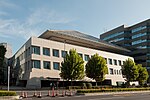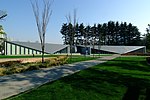Park Court Akasaka The Tower

Park Court Akasaka The Tower (パークコート赤坂 ザ タワー, Park Court Akasaka The Tower) is a 157-meter highrise building located in Akasaka, Minato, Tokyo, Tokyo.The 43 floor 71,339-square-meter residential condominium tower was completed in 2009 and houses 521 units. It features a sky lounge on the 36–37th floors, a rooftop terrace, and underground parking.The building is located in central Tokyo next to Aoyama-dori and the Akasaka Imperial Grounds with Akasaka Palace and Togu Palace, and within 10 minutes walk of Tokyo Metro stations Aoyama-itchōme, Akasaka, Akasaka-mitsuke, Nagatachō, Kokkai-gijidō-mae and Tameike-Sannō, with access to Ginza Line, Hanzōmon Line, Marunouchi Line, Yūrakuchō Line, Chiyoda Line, Namboku Line and the Toei Ōedo Line.
Excerpt from the Wikipedia article Park Court Akasaka The Tower (License: CC BY-SA 3.0, Authors, Images).Park Court Akasaka The Tower
Minato
Geographical coordinates (GPS) Address Nearby Places Show on map
Geographical coordinates (GPS)
| Latitude | Longitude |
|---|---|
| N 35.67325 ° | E 139.73179 ° |
Address
107-8371 Minato
Japan
Open on Google Maps











